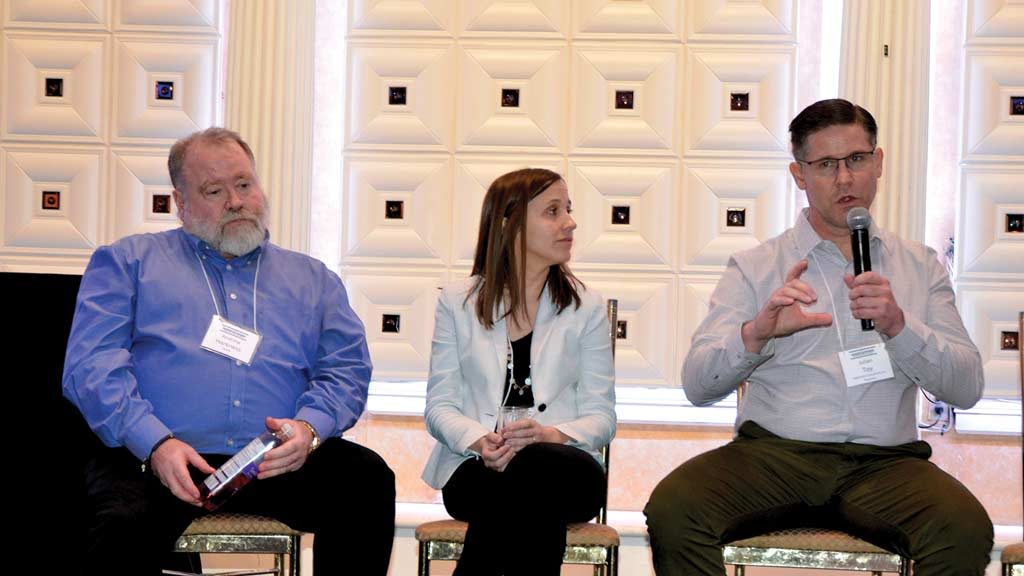A panel of professionals offered tips for dealing with mental illness and substance use disorder in the workplace at the recent OGCA Leadership Conference.
Julian Toy, a substance abuse professional with Addiction Consultants in Recovery, who drank alcohol and used drugs daily for 16 years while holding jobs like machine operator and welder, said he knows people who come into recovery that have a mental health condition. The substance use disorder may have started because they were medicating for the mental health condition.
“If someone has a mental health condition and a substance use disorder, they need to be properly medicated for their mental health condition and in recovery…abstain from all other substances in order to get well,” Toy explained to attendees at a conference organized by the Ontario General Contractors Association (OGCA) and the Infrastructure Health and Safety Association.
Dr. Nancy Carnide, a scientist with the Institute for Work & Health, who along with a team is leading a survey on cannabis in the workplace, said that employers need to look at how the workplace may be contributing to substance use.
“We see that workers in our survey are reportedly using cannabis for anxiety, pain, sleep or stress and a large proportion of those workers are also saying it’s because of work,” said Carnide. “They are using cannabis to help medicate themselves. It’s thinking about those aspects in our workplaces and how do we improve our workplaces so that workers don’t have to do that.”
Carnide said while the Canadian Standards Association is developing a standard on impairment in the workplace, it won’t be available for some time.
“There is work being done to help employers navigate the minefield of impairment,” she said.
“I completely appreciate how difficult this is for employers because the science isn’t there yet… We can’t say with any sort of consistency that there is this one safe waiting period, as long as you wait this long you should be fine to go to work. There are some guidelines out there but they are not consistent.”
One of the key things to do is educate workers to ensure they are fit for duty.
“It’s making sure your employees understand about not being impaired so if they are going to use substances outside of work, they are doing it in a way that doesn’t spill into the workplace,” Carnide said.
Having a mental health strategy is also key.
“Many organizations approach us because they have had a traumatic event at work,” explained Andrew Harkness, strategy advisor, organizational health initiatives, Workplace Safety and Prevention Services. “That’s never the place you want to start… Think about it in the same way you would talk about any other hazard in your workplace. One of the first steps is we need to educate people on what this type of hazard is. It’s not so much about mental illness, it’s about mental injury and mental harm prevention and when you educate your workforce to understand that concept, I think it goes a long way to then be able to look at what are the measures we now are going to take.”
The first group to work with are people in leadership roles.
“Start with your managers and supervisors and help them recognize that what we are needing going forward is a different style of people leadership — it’s coaching, it’s working with in collaboration, it’s empowering,” said Harkness. “For people that have not been trained or informed or are still old school in terms of how they were developed as managers, we’ve got to help them realize that’s not insubordination, that’s not a challenge to authority, that’s not aspects of undermining the workplace.”
He recommends finding a needs assessment tool that will help “pick out the pain points.”
“You really want to make sure you are going in the right direction so work on the things that are going to be of the most interest to your employees,” Harkness noted. “This is all about the employee experience. We can talk all you want about having programs and procedures but if they aren’t being utilized, we need to make efforts in being able to understand why.”
Harkness encouraged employers to sit down with employees they suspect might have an issue, have a conversation and encourage them to get help.
“You don’t want to centre people out,” Harkness noted. “You are also not a doctor, psychologist, psychiatrist or therapist. The benefit of having things like an EAP (Employee Assistance Program) and resources, is that you have a tool to point them towards. It’s still somebody’s choice. But I would be strongly encouraging that employee and saying, “I’m not diagnosing anything but I’m noticing a change in you the past couple of months, is everything OK?’ Try and encourage that individual to seek help… It’s difficult for you to hand a card to someone and say call this number. What you may want to say to your staff person is “if you like, I will make the call with you.”
Follow the author on Twitter @DCN_Angela.











Recent Comments